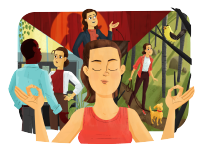
After I facilitated a workshop on executive presence at a law firm, a participant came up to me and commented that she saw some overlap between my advice and the material she was learning in yoga teacher training—something she was pursuing on evenings and weekends. As someone who has practiced yoga for several years, I had never considered how the basic tenets of yoga are helpful practices at the lectern too.
On reflection, I realized my workshop participant was on to something. Since then, I have identified four habits that I think benefit practitioners of both yoga and public speaking.
Breath

In yoga, there is a focus on deep, smooth and controlled inhalation and exhalation that initiates each movement of the body. Likewise, paying attention to breath is helpful in managing nervousness associated with public speaking. When speakers get anxious, their breathing tends to get fast and shallow—causing them to speak at a fast rate and with a breathy quality. Fast, shallow breathing can even lead to hyperventilation and an “out-of-body” feeling at the lectern.
Consciously deepening and lengthening the breath, especially right before you speak when nervousness generally spikes, can help lower the heart rate and allow for a louder, richer and slower vocal quality.
Presence
Slowing the breath also promotes being present. Yoga teachers often remind their “yogis” to become more aware of their breath and to be in the present moment—not worrying about what happened before class or the to-do list waiting to get done later in the day. The focus on staying in the moment is important for public speakers too.
Think about speakers you admire. They likely aren’t perfect—they’ll have a few hiccups in their speech, a typo on a slide, a few junk words. But they don’t dwell on them. They focus on authentically connecting with listeners—sharing a story or idea that is meaningful. This connection can only happen when speakers are present in the moment. Sounds easy, but how can speakers be more present?
- Thoroughly understand the audience and context.
- Be passionate about the topic. Reference areas of importance and interest to yourself and the audience. Provide helpful information.
- Carefully prepare to avoid dependence on a script or outline.
- Smile and relish the role of presenter.
- Look into the eyes of listeners and have a conversation with them, not at them.
Posture
In addition to being present in the moment, yoga enthusiasts cultivate body awareness as they move through yoga poses. They pay attention to grounding their feet, aligning their hips, opening the heart and creating space between each vertebra in their back. I find one of the most rewarding aspects of practicing yoga is the “aha” moment when you finally achieve proper alignment in a posture or deepen your experience of a pose you’ve done hundreds of times in the past.
“Presenters must cultivate a stable, open and tall posture that conveys confidence and avoids distracting movements.”
A focus on proper alignment and purposeful movement is also key for a public speaker. For optimum stage presence, presenters must cultivate a stable, open and tall posture that conveys confidence and avoids distracting movements. This starts from the ground up—with feet planted on the ground in a wide, athletic stance, hips level and not popped to one side. Keep the chest “proud” with shoulder blades pressed together, hands at the sides rather than clasped, and head high with the crown reaching toward the ceiling.
Once the body is calm and expansive (this will take some practice), speakers can use body language to make their presentations more dynamic.
As a speaker, you might experience an “aha” moment of proper alignment and posture when you:
- Take time to achieve a stable, open and tall posture at the lectern before saying a word.
- Stop clasping the lectern and even move away from it while you speak.
- Calmly handle a prop, or gesture toward visual aids.
- Move your body to reenact a story, explain a process or emphasize structure of the speech.
- Stand and smile confidently at the end of your speech as you receive applause.
Acceptance
One of the most difficult yoga lessons is acceptance—accepting your body as it is, not what it could do yesterday or what you want it to do in the future. Don’t compare yourself to the person next to you. Similarly, accept that as a public speaker, some aspects of presenting will come easily and others will be more of a challenge. You will have both incredible performances and speeches you wish had been better.

It is important not to get frustrated or judge yourself harshly when you struggle or give an off performance. It doesn’t mean you are a poor speaker. Accept that it is a proficiency that challenges you, or that it was an off day. Then, let it go. Focus your energies by reflecting on ways you can improve, leveraging your strengths and preparing as best you can for the next presentation.
These four yoga habits—breath, presence, posture and acceptance—are instructive for public speakers to consider (even if they don’t practice yoga). I’m grateful that my program participant helped me make the connection. Learning from audience members is one of the greatest gifts of presenting.
Christine Clapp, DTM is the founder and president of Spoken with Authority, a presentation skills consultancy that elevates the presence and expands the influence of subject-matter experts, leaders, and emerging leaders. She is the co-author of three books, most recently Presenting Now: A Guide to Public Speaking and Leadership Communication Online, in Person, and Beyond.



 Previous
Previous
 Previous Article
Previous Article

